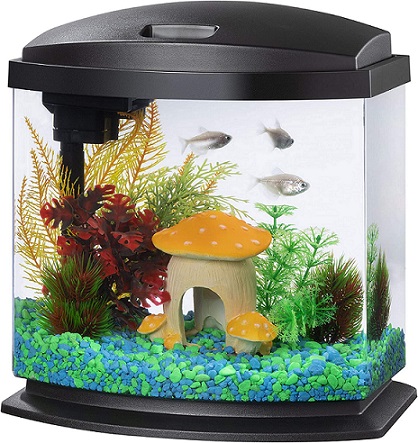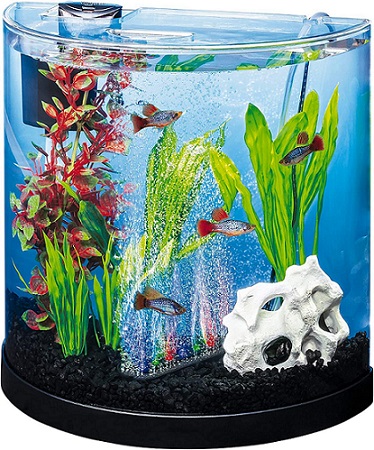
Aquariums are still the best alternative to recreate optimal conditions for fish development. Today, they are more and more popular on the market, but choosing the right equipment is not always easy. There are several parameters to take into account to get the ideal model.
If you don’t have time to read this review, here are two references whose performance has impressed consumers. First, you have the Aqueon LED MiniBow Kit which is very practical since it’s lightwight and fit on practically any sturdy surface. Secondly, we have the Tetra ColorFusion, an aquarium with LED lighting as its name suggests. Ideal for a first starter tank.
Our Selection Process
We did a deep dive on the internet for a wide variety of fish tanks that could suit homes of different sizes and fish owners with varying amounts of time to dedicate to maintaining their tanks. The two tanks we’ve selected are great for people who are just starting out. Below, check out our picks for the best fish tanks for beginners on the market.
Buying Guide – What To Look For
By basing yourself on a few criteria, you can easily identify the best aquarium on the market. It will be the one that meets your expectations and will contribute to the development of your fish and other marine animals. If you want more details, follow these tips that we deliver to you.
The volume
This feature should be in pole position in your list of parameters when you are about to consult a price comparison. Experts in the field recommend a model whose capacity does not fall below 120 L. This is especially true for those who are new to aquarium keeping. The reason for this is that the larger your equipment, the easier it will be to maintain.
If your pet is cramped in its tank, it will become more susceptible to stress and other diseases. A large volume prototype also provides a certain balance in terms of biochemistry. But also, this criterion will allow you to identify the number of fish that will take refuge there.
Scientists estimate that one liter of water is sufficient for 1 cm of your pet. If yours is about 5 cm long and you have 150 liters available, your tank will be able to hold about 30 fish. If you have larger fish of more than 20 cm, you should count on up to 2 l for each centimeter of fish. All you have to do is make a little calculation before deciding where to buy a new aquarium.
Size and installation
This criterion is closely related to the one we mentioned above. And in a buying guide for the best aquariums, connoisseurs do not omit to raise this point. This element is to be taken into account according to the capacity of the room in which you plan to install the structure. Make sure you have the necessary surface area to accommodate your equipment so that it does not clutter your space or hinder your movements.
Note, however, that the location of your equipment must meet certain conditions. Don’t forget that peace and quiet is essential. Prefer a quiet place while being sheltered from daylight with an electrical outlet nearby. In any case, you will have to deal with two modes of installation according to the models proposed by the manufacturer. The most widespread in the trade remain those to be posed. All you have to do is find a sturdy piece of furniture on which to install your aquarium. This seems to be the simplest method. There are also wall-mounted models. They usually come with a hanging rail. With these references, you will save floor space.
The shape and structure
To know how to choose the best aquariums of 2022, you will also need to consider the design of your future equipment. Today, traditional jars are being abandoned in favor of rectangular specimens. According to scientists, the former would be one of the main causes of stress in fish because they distort their vision. In fact, in Italy, the government prohibits the sale and use of this type of equipment. Rectangular models come in a variety of colors depending on the finishes provided by the manufacturer.
For the design material, we generally meet two categories: glass and Plexiglas. Respectively, the first one remains prized for its elegant aesthetic. Although it seems quite sensitive to scratches and breaks, it is hygienic and easy to maintain. On the other hand, the second one remains robust in front of intensive manipulations. It is usually cheaper if you have a budget limit to keep.
Additional options
How to buy a better value aquarium? Simply by looking at the options built into your product. While some models are only sold empty, others interest consumers for the extra accessories that come with them. One of these is the filter. If it is not included in the package, you should still get it, because it will eliminate waste that will affect the well-being of your pet. Here you can choose internal or external modules.
The lighting is also among the parameters to consider. You will have to select it according to the species. In addition, be careful to check the type of lamps, because it may be that their intensity is intended either for the development of fish or for the growth of plants.
Best Aquariums for beginners – Our Top 2 Picks
A fish tank can be a great addition to any home, and can provide hours of enjoyment for the whole family. But if you’re new to keeping fish, it’s important to choose the right tank for your needs. Here are five of the best fish tanks for beginners, each with its own unique features:
Best overall: Aqueon LED MiniBow Kit

Pros
- Lightweight and compact
- Great for smaller fish
- Comes with multiple accessories
Cons
- Some users find the filter is too strong
Key Specs
- Dimensions: 11.9 x 9.8 x 11.9 inches (2.5-gallon size)
- Weight: 3.75 pounds
- Capacity: 1, 2.5, or 5 gallons
Fish newbies will love this tank. It’s less than four pounds and you can put it on any solid surface, so there’s no need for weights hooks like you would with a bigger one. Its compact design also takes up a lot less space
This aquarium is a great place to begin for smaller fish, it has everything you need to get started including the tank, hood, elevated base and more.
The tank’s filter can clean water in under 2 minutes, but when it needs to be deep-cleaned, the removable lid makes it easy to do so.
Best design beginner tank: Tetra ColorFusion Starter Aquarium

Pros
- Affordable
- Easy to maintain
- LED lights add some fun to the tank
Cons
Can only hold a smaller number of fish
Key Specs
- Dimensions: 6.9 x 12.5 x 12.9 inches
- Weight: 1 pound
- Capacity: 3 gallons
This starter aquarium from Tetra is a must-have for your first fish or two. It has everything you need and features a half-moon design that lets you check in on your fish from nearly every angle.
It’s got a filter to keep the water clean so your fish loves this tank and you never have to worry about maintaining it.
The inner lid on this tank is clear which allows you to feed your fish without taking the lid off. Plus, there are built-in LED lights that let you choose the tank’s interior lighting at any time.
Frequently asked questions
Q1: How do I clean an aquarium?
Before starting, remove the fish from the water with a landing net and transfer it to another container. Make sure the temperature of the receiving water is the same as the temperature in the tank to avoid thermal shock. Next, start with the inner walls. Use a cloth, abrasive sponge or glass scraper during the process.
Be careful not to use any chemicals, as their residue could be harmful to your pets. Uninstall the filter and rinse it with clean water. For the water, you only need to change 1/3 of the total volume so as not to eliminate the bacteria essential to the survival of your fish. As for the substrate, vacuuming is enough to remove unwanted elements. For ornaments, remove them and wash them separately.
Q2: How many fish in an aquarium?
In aquarium keeping, it is essential to respect a fundamental rule. Experts always recommend taking 1 cm of fish size for 1 l of water in the tank. If you have a 100 l tank, you can keep about 5 fish of 5 cm, taking into account the presence of decorations and substrate. For larger species of more than 20 cm, you should take 2 or 3 cm of length for 1 liter so that your marine animals do not feel cramped in their habitat.
Q3: How to get rid of algae in an aquarium?
You will only be able to get rid of these unpleasant vegetations if you identify them beforehand. You can recognize them by their colors and then take the appropriate steps. The green ones, for example, are easily removed with the hands. They are the result of too much light. Also try to reduce the brightness. If they are brown, it is that the opposite phenomenon occurs. They are the result of a lack of light.
Other algae of various shades can also appear after a biochemical imbalance of the water such as the strong presence of nitrates, phosphates or ammonia. To remedy this, regular maintenance of the aquarium with more frequent water changes is recommended. Maintaining a good temperature is also recommended.
Q4: How do you calculate the volume of an aquarium?
Calculating the volume of an aquarium is a relatively simple process. Simply multiply the length with the width and height of the structure. Then divide the total by 1000.
Q5: Where should the filter be placed in an aquarium?
This device is installed in the middle of the tank. In this way, it will offer a better mixing of the water and an easy redirection of the current from the left to the right and vice versa.
Q6 : How to make a water turtle aquarium ?
To begin, get a tank that is adequate for the size of your animal, taking into account the aquarium rule. Then, equip it with the necessary accessories to recreate the conditions of survival of your turtle: filter, lighting, system of adjustment of the water temperature, substrate and vegetation. Also, you must know that these specimens need a dry zone which can be arranged with sand and gravel. You must then distribute the submerged and submerged part according to the species of your tortoise. If some of them need 50% of water in the tank, others can only thrive with 75% of water or more in the aquarium.
- Feeding Eggs To Fish - December 27, 2022
- Cure Swim Bladder Disease In Fish - December 27, 2022
- Can Damaged Fins Grow Back? - December 27, 2022
